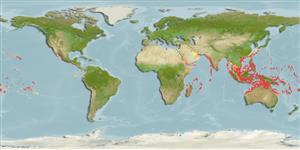Common names from other countries
Environment: milieu / climate zone / depth range / distribution range
पारिस्थितिकी
समुद्री प्रवाल-भित्ति संयुक्त; गहराई सीमा 5 - 65 m (Ref. 90102), usually 20 - 65 m (Ref. 27115). Tropical; 22°C - 28°C (Ref. 27115); 35°N - 25°S
Indo-Pacific: Red Sea and Kenya east to Hawaiian Islands, Fanning Islands and Samoa; northward to Japan south to Australia. Apparently not found off New Zealand (Ref. 8991).
आकार / वज़न / Age
Maturity: Lm ? range ? - ? cm
Max length : 45.0 cm SL पुल्लिंग / अलिंग; (Ref. 8991); common length : 35.0 cm SL पुल्लिंग / अलिंग; (Ref. 9645)
पृष्ठीय रीढ़ (सम्पूर्ण) : 3 - 4; पृष्ठीय सौफट रेज़ (सम्पूर्ण) : 43 - 47; गुदा कांटा: 1; ऐनल सौफट रेज़: 37 - 40.
Found on outer reef slopes, hovering above the bottom. They swim often high above the substrate to pick prey from the substrate with their excellent eyesight (Ref. 48635). Tends to swim away from its pursuer rather than enter its burrow (Ref. 1602). Solitary or in pairs (Ref. 9710), adults form monogamous pairs (Ref. 37816). Maximum depth from Ref. 027115.
Life cycle and mating behavior
Maturities | पुनरुत्पत्ति | Spawnings | Egg(s) | Fecundities | लार्वा
Monogamous mating is observed as both obligate and genetic (Ref. 52884).
Dooley, J.K., 1978. Systematics and biology of the tilefishes (Perciformes: Branchiostegidae and Malacanthidae) with descriptions of two new species. NOAA Tech. Rep. NMFS Circ. No. 411:1-78. (Ref. 8991)
IUCN Red List Status (Ref. 130435)
CITES (Ref. 128078)
Not Evaluated
Threat to humans
Harmless
Human uses
मात्स्यिकी: व्यापारिक; जलजीवालय: व्यापारिक
साधन
Special reports
Download XML
इंटरनेट स्रोत
Estimates based on models
Preferred temperature (Ref.
115969): 24.6 - 29, mean 27.9 (based on 1578 cells).
Phylogenetic diversity index (Ref.
82804): PD
50 = 0.6250 [Uniqueness, from 0.5 = low to 2.0 = high].
Bayesian length-weight: a=0.00537 (0.00236 - 0.01221), b=3.03 (2.82 - 3.24), in cm Total Length, based on LWR estimates for this (Sub)family-body shape (Ref.
93245).
Trophic level (Ref.
69278): 3.5 ±0.50 se; based on food items.
Fishing Vulnerability (Ref.
59153): Moderate vulnerability (42 of 100).
